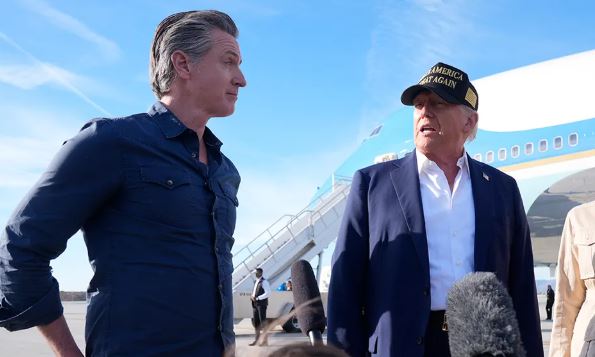What happens when a state decides it’s had enough of federal overreach and takes on the world stage solo? On April 8, 2025, California Governor Gavin Newsom dropped a bombshell that’s shaking the foundations of U.S. trade policy—challenging President Donald Trump’s tariff blitz by inviting global partners to deal directly with the Golden State. This isn’t just a political stunt; it’s a calculated rebellion that could redefine the balance of power between state and nation. Is Newsom’s move a visionary defense of California’s economic might, or a reckless plunge into uncharted legal and political waters? Let’s unpack the layers of this high-stakes drama that’s got everyone talking.

The Tariff Tempest Unleashed
The saga began when Trump unveiled his ” Liberation Day” tariff plan, effective April 9, 2025—a 10% tax on all imports, with a staggering 50% levy aimed at Chinese goods. The fallout was immediate: China slapped a 34% tariff on U.S. exports, Canada targeted American autos, and the Dow tanked 1,400 points in a single day. Economists project a 2.3% inflation spike, adding $3,800 to annual household costs. For California, home to the nation’s busiest port and 14% of U.S. GDP, the stakes are colossal. Newsom’s response? A defiant call to action on April 4: “Trump’s tariffs don’t speak for all Americans—certainly not Californians.”
His strategy is bold—leverage California’s status as the world’s fifth-largest economy to negotiate exemptions from retaliatory tariffs. But this isn’t just about economics; it’s a philosophical stand against centralized control, rooted in the state’s history of pushing boundaries.
California’s Economic Arsenal
Let’s talk numbers. California’s $675 billion in annual trade isn’t pocket change—it’s a lifeline supporting millions of jobs. The state dominates U.S. agriculture, producing nearly all almonds, and its manufacturing sector is a national leader. Yet, Trump’s tariffs threaten to choke these industries. China’s 35% tariff on almonds alone could cost billions, while a 10% drop in cargo at the Port of Los Angeles jeopardizes post-wildfire recovery. Newsom’s pitch to the world—“California remains a stable partner”—is a calculated flex of this muscle, betting that global players will prioritize access to its market over federal compliance.
This isn’t blind optimism. California’s clout gives it leverage few states can match. With 40 million residents and a GDP rivaling entire nations, it’s a prize worth courting. But can it really pull off direct diplomacy without Washington’s blessing?
The Legal and Political Minefield
Here’s the rub: the U.S. Constitution hands trade authority to the federal government, not states. Experts like Jock O’Connell of Beacon Economics call Newsom’s plan “unworkable” if it crosses into formal treaties—Congress would likely strike it down. Yet, informal talks? That’s a gray area. Newsom’s team insists they’re “engaging partners,” not signing deals, a tightrope walk to avoid legal blowback. The White House isn’t amused—spokesperson Kush Desai quipped, “Newsom should fix California’s homelessness crisis, not play diplomat.”
Critics argue this flirts with rebellion, echoing historical tensions like the Civil War era. Supporters counter it’s a necessary evolution—states must adapt when federal policy threatens their survival. Newsom’s term ends in 2026, and with no re-election on the table, this could be his legacy-defining moment—or a stepping stone to 2028 ambitions.
A Global Game-Changer?
The world’s reaction is telling. Canada’s wine tariffs and China’s broad retaliation signal a trade war spiral, but Newsom’s outreach offers a lifeline. If nations bite—say, exempting California almonds or tech exports—it could fracture U.S. trade unity, emboldening other states. Success might stabilize prices and jobs in California while Trump’s tariffs batter the rest of the nation. Failure? Economic isolation or a constitutional crisis looms.
This isn’t just about tariffs—it’s a test of federalism. Can a state wield global influence when the White House falters? California’s past—think Jerry Brown’s climate deals—suggests it’s not afraid to lead. But this time, the stakes are higher, the opposition fiercer.
Vision or Delusion?
Newsom’s defiance taps into a deep truth: California’s economy is too big to ignore. If he succeeds, it’s a masterclass in statecraft, proving regional power can counter national chaos. If he fails, it’s a cautionary tale of overreach. Either way, this rebel stand signals a shift—states aren’t just cogs in the federal machine anymore. As the tariff war unfolds, California’s gamble could reshape how we view power, trade, and America itself. Will the world take the bait? Only time will tell, but one thing’s clear: Newsom’s not backing down, and that’s a story worth watching. What’s your take—brilliant or bonkers?





